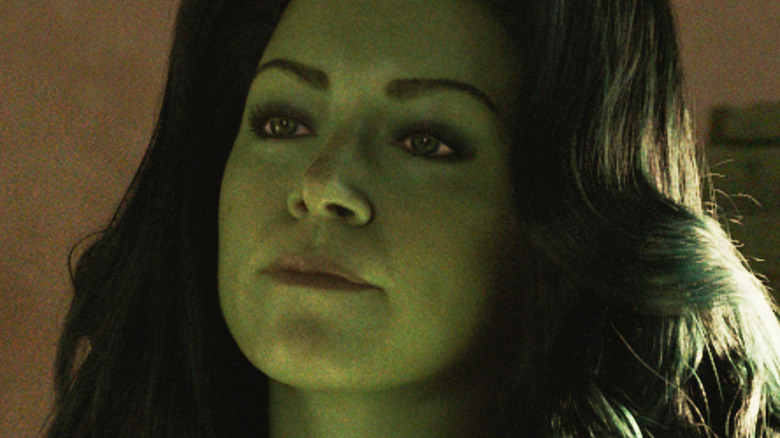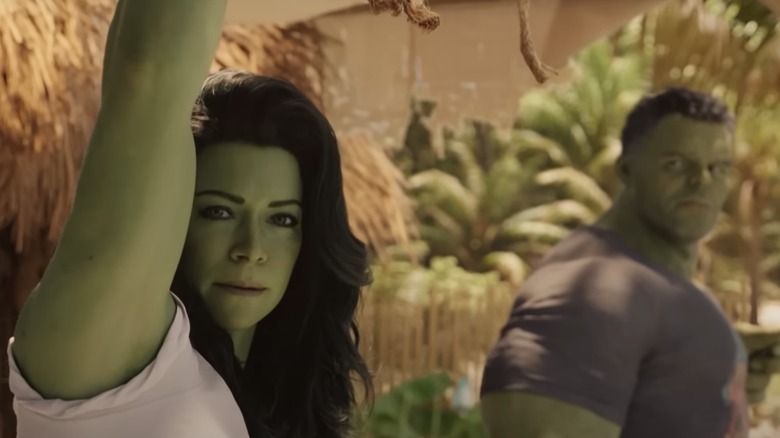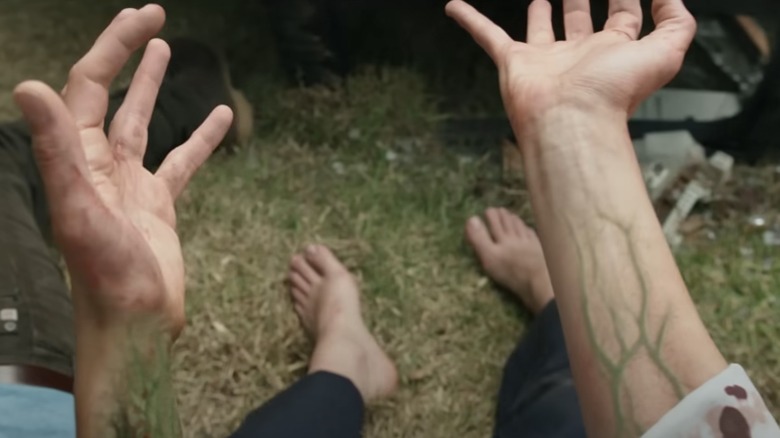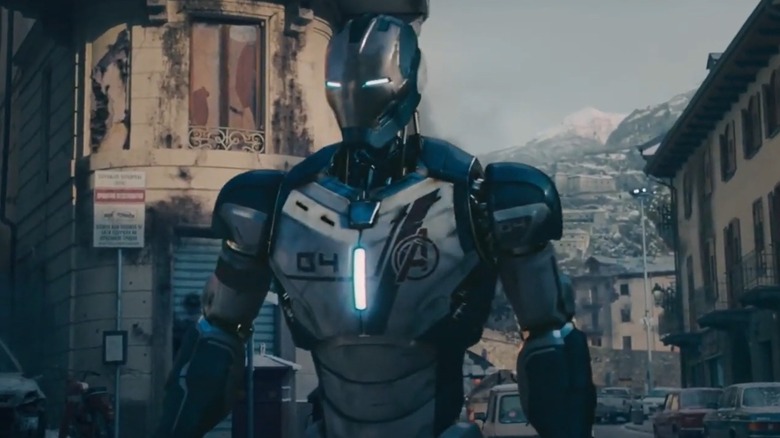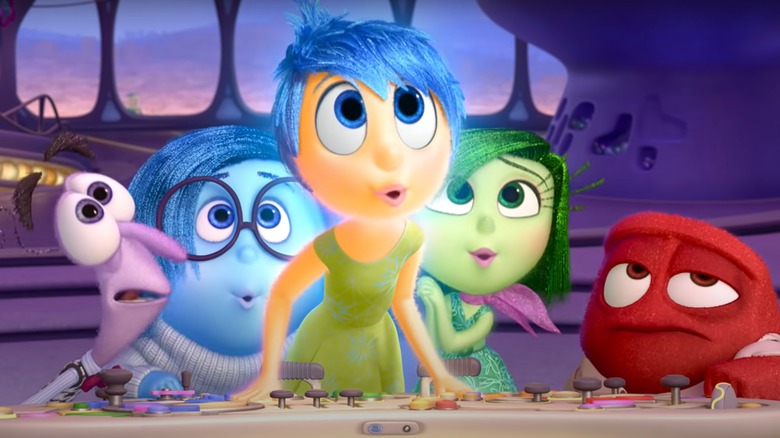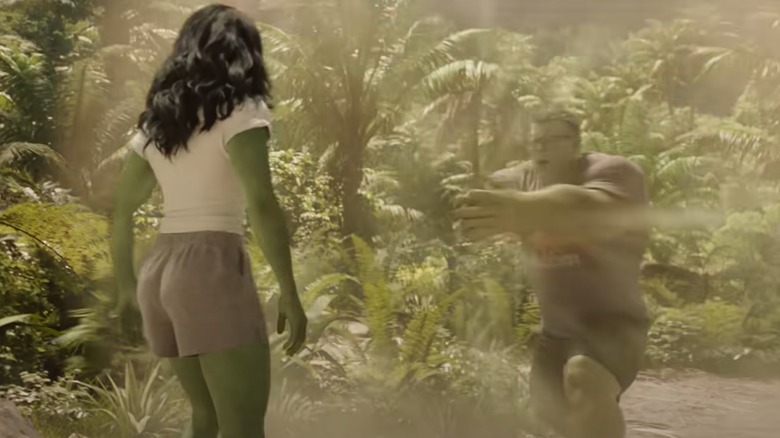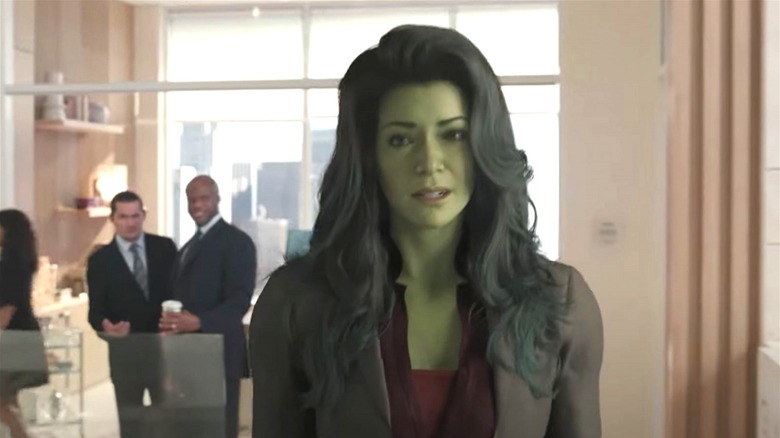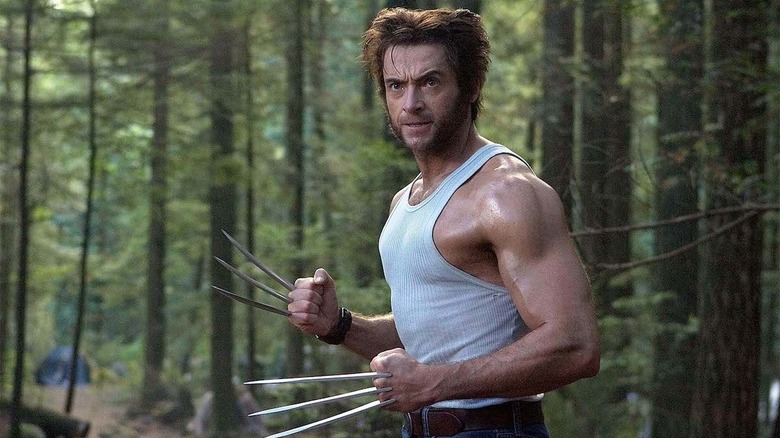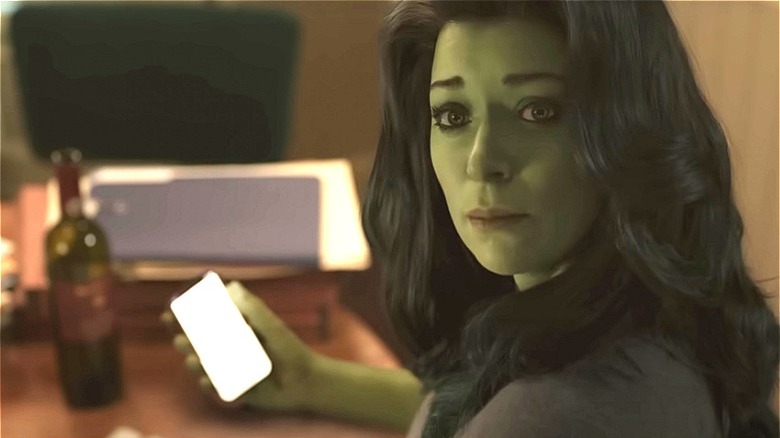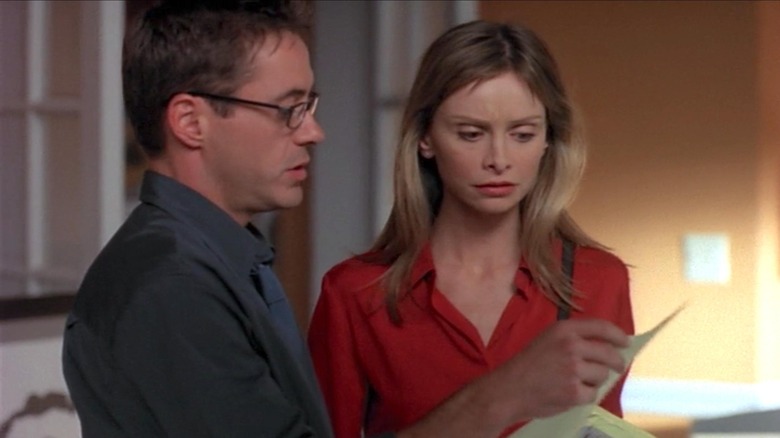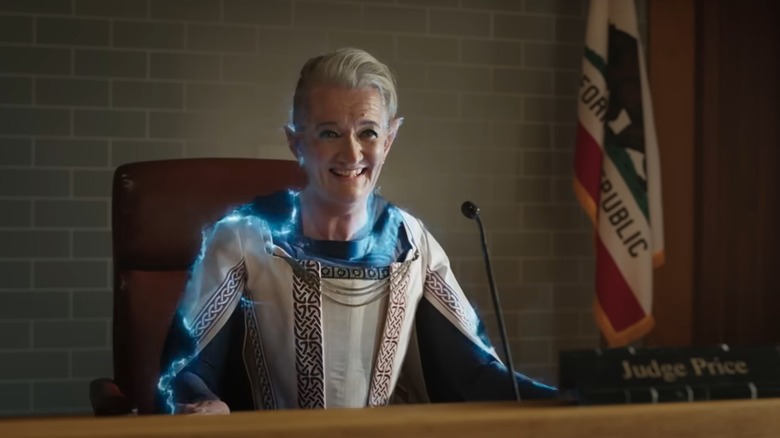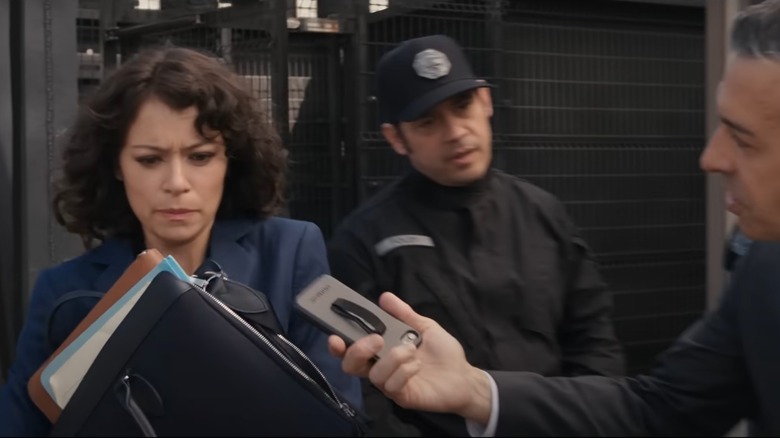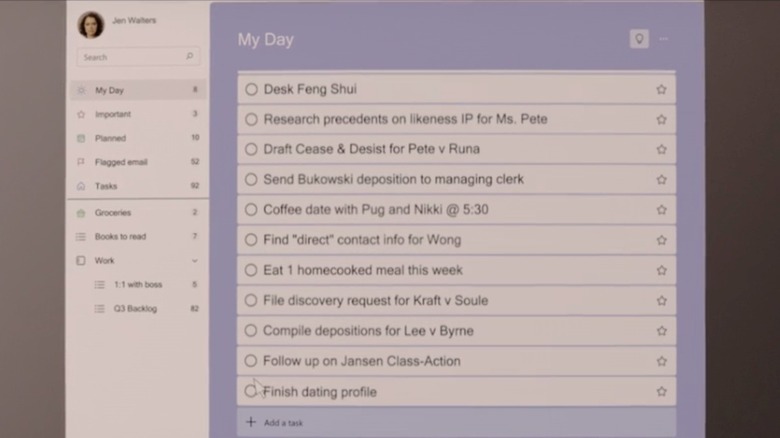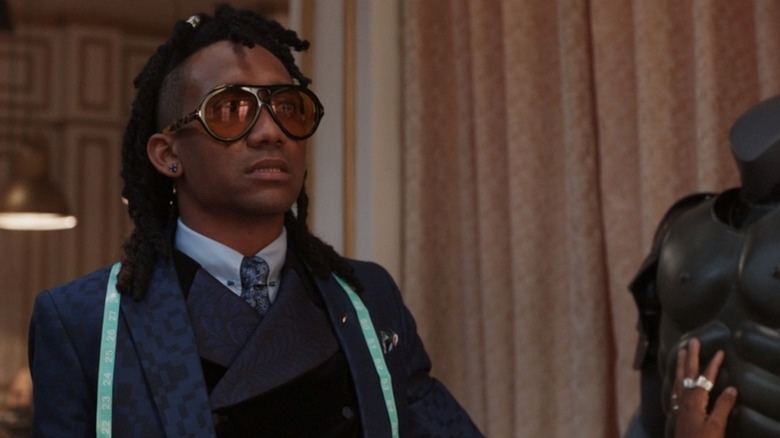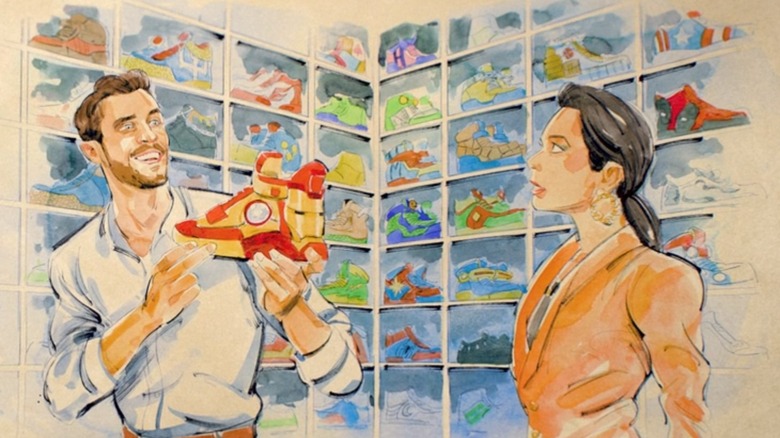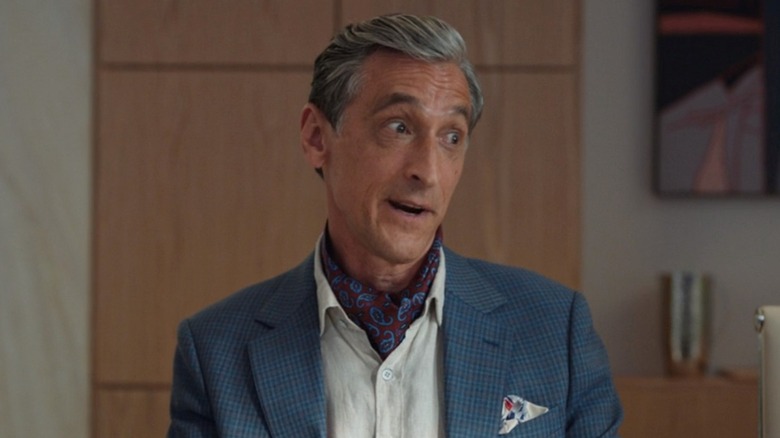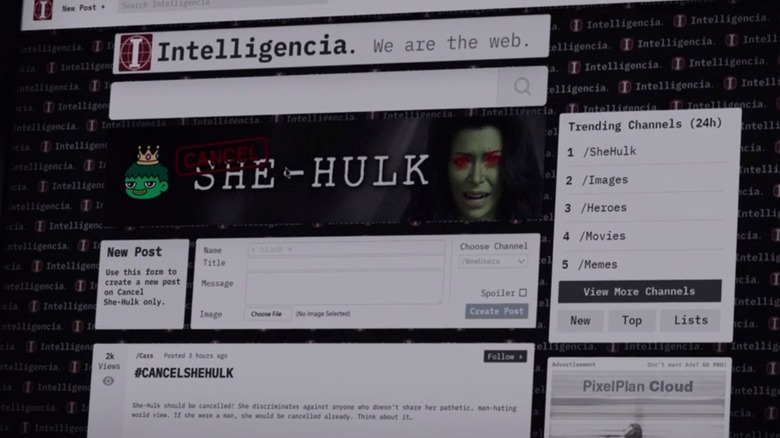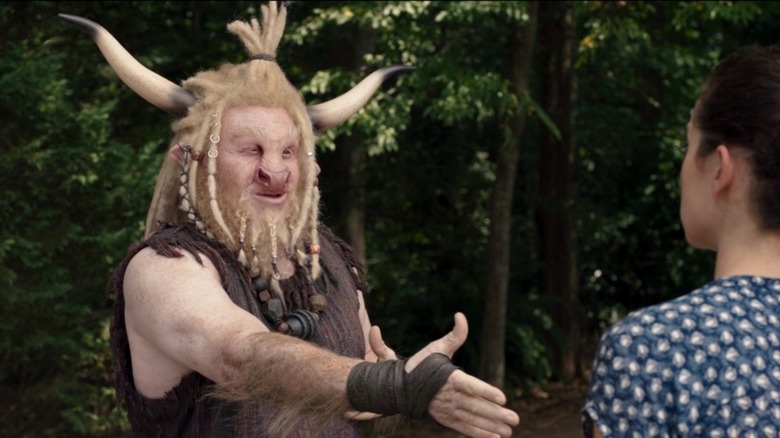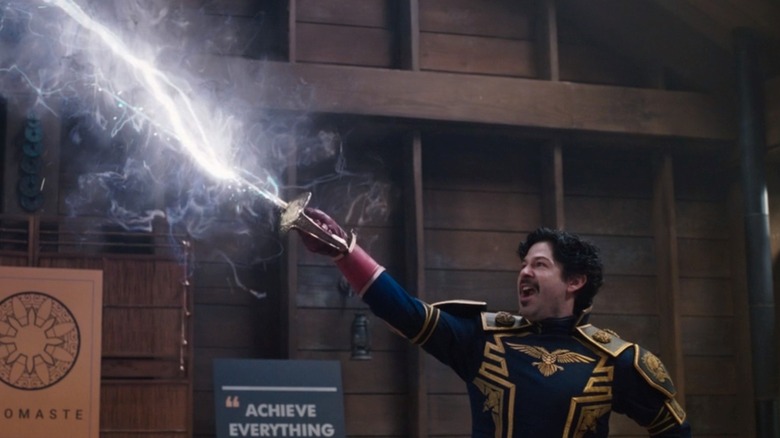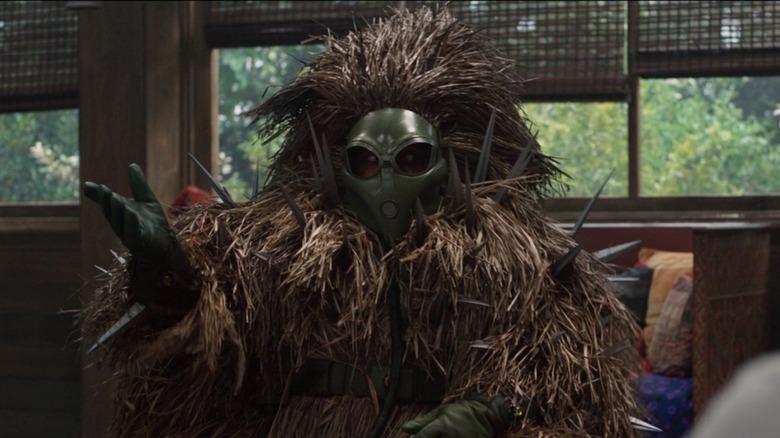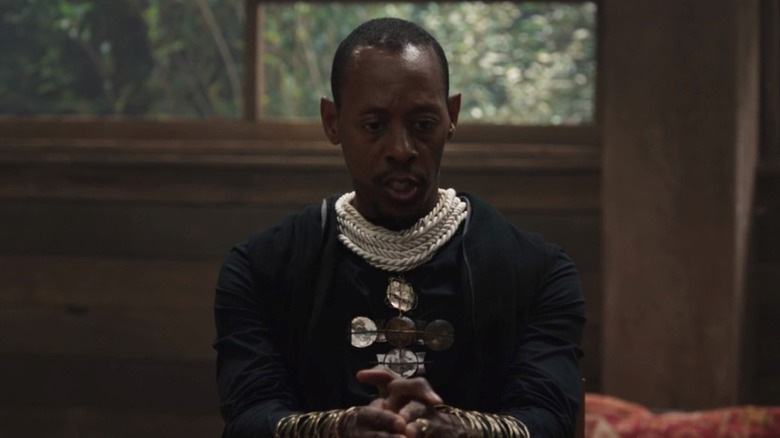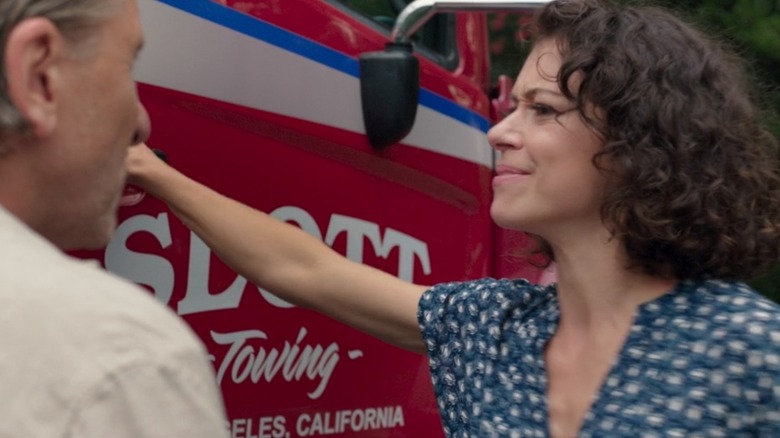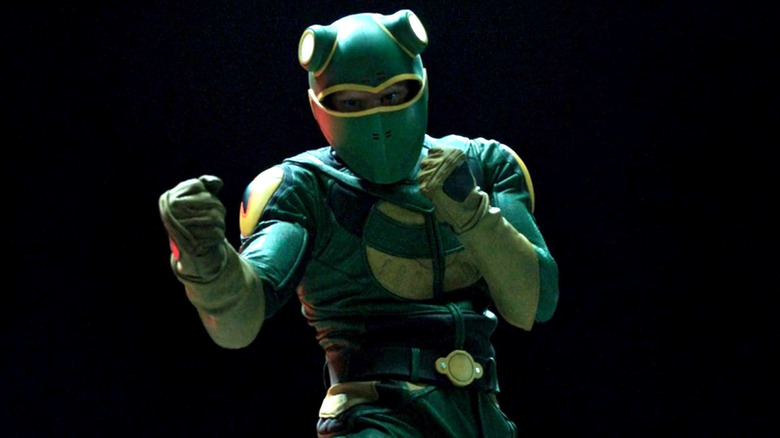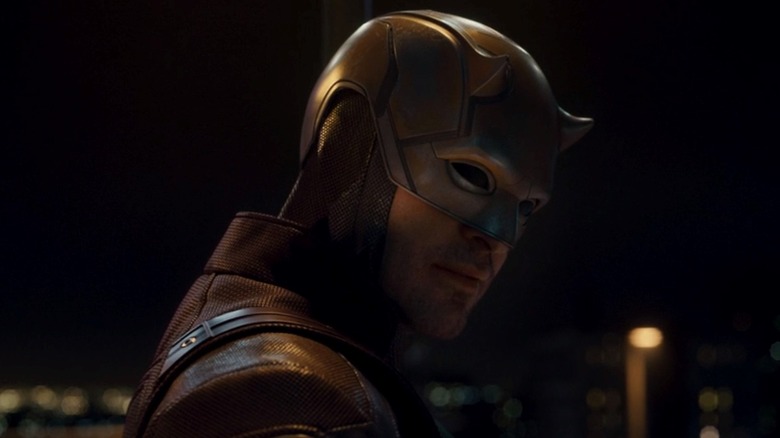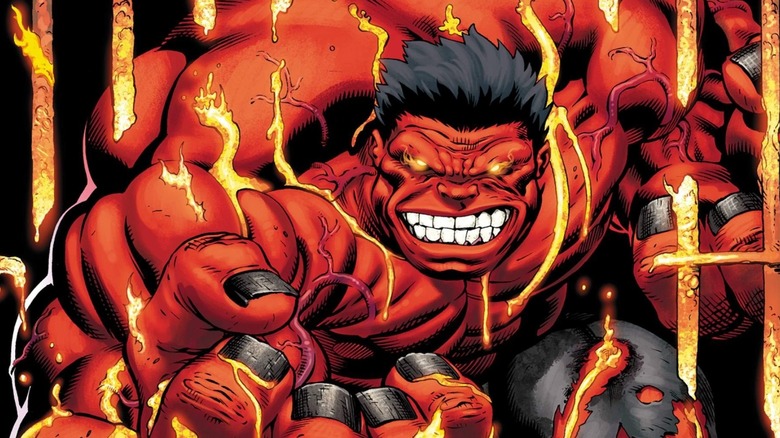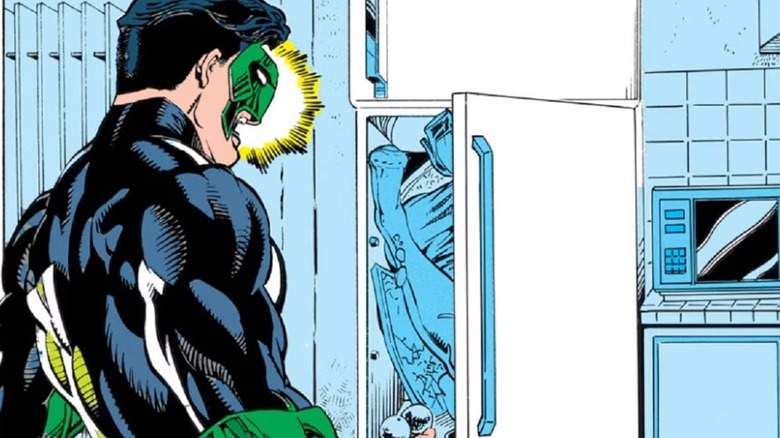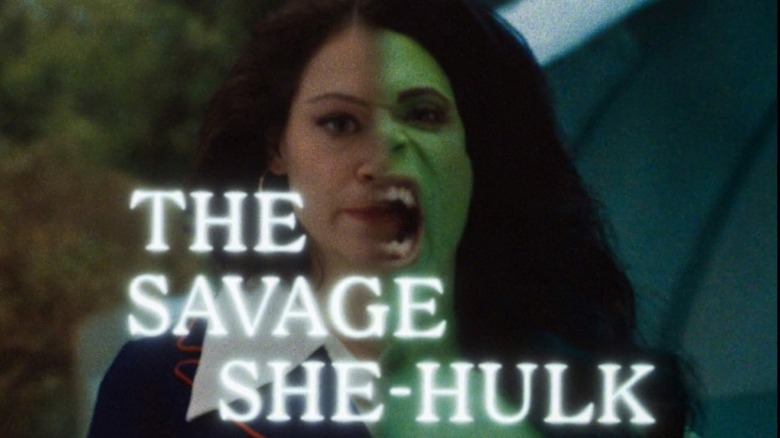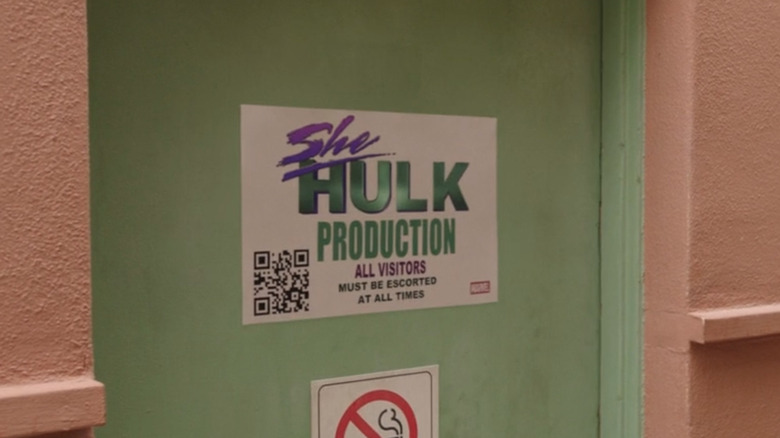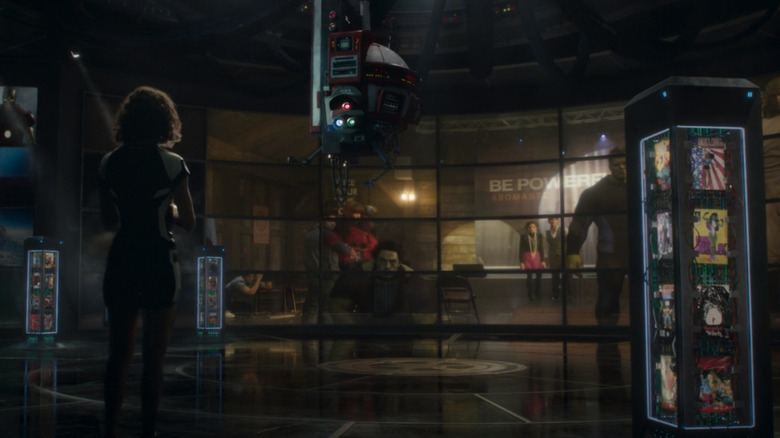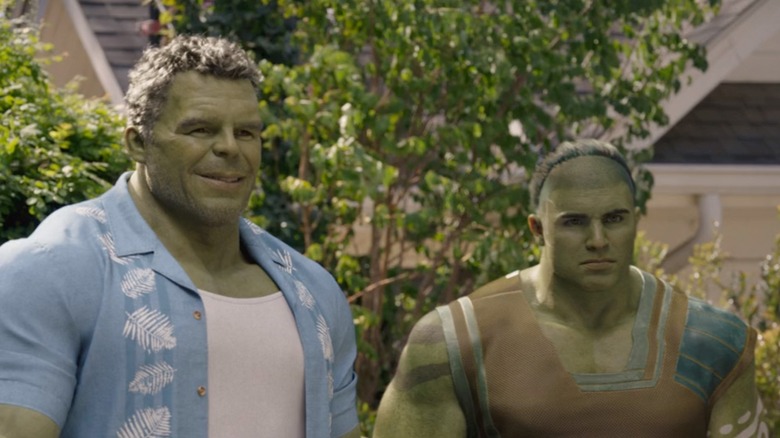Easter Eggs You Missed In She-Hulk: Attorney At Law
Starring Tatiana Maslany as the titanic titular comic book hero, "She-Hulk: Attorney at Law" offers something the MCU has never seen before: a workplace comedy. Cousin to Bruce Banner (Mark Ruffalo), the Avenger now known as Smart Hulk, Jennifer Walters is a lawyer living in Los Angeles. Her life changes forever when a transfusion of Bruce's gamma-irradiated blood turns her into the one and only She-Hulk. As Jennifer soon learns, it's not easy being green: She must now navigate the demands of being a superhero while maintaining a social life and taking on a job at a prestigious firm's new superhuman law division.
Marvel Comics readers know She-Hulk for her super-strength, scintillating wit, and sensational ability to break the fourth wall. This final trait sets her apart from most heroes in the MCU, and "She-Hulk: Attorney at Law" bursts at the spandex seams with pop culture allusions and comic book tie-ins. Want to understand them all? Then read on to discover the Easter eggs you may have missed in "She-Hulk: Attorney at Law."
Warning: Spoilers ahead!
Breaking the fourth wall
Viewers watching "She-Hulk: Attorney at Law" for the first time may be surprised when, during the opening scene, Jennifer Walters looks at them directly and says, "It's true, I am a Hulk!" Longtime Marvel Comics fans, however, will happily recognize She-Hulk breaking down the fourth wall to acknowledge she's a fictional character.
As head writer Jessica Gao revealed to Total Film (via Games Radar), fourth wall-demolishing tragicomedy "Fleabag" is a major influence on "She-Hulk: Attorney at Law." But Jennifer Walters has been having metafictional adventures since John Byrne's "Sensational She-Hulk" #1 hit the stands in 1989. Gao has praised Byrne's work, telling Variety that Jennifer's rule-breaking irreverence is rooted in his reinvention of the character.
The opening scene of Episode 1, "A Normal Amount of Rage," sets the tone for the series with even more comic book references. Nikki Ramos (Ginger Gonzaga), Jennifer's paralegal and best friend, suggests she show the court a savage look. This is a nod to Jennifer's very first Marvel Comics series, "Savage She-Hulk." Audiences should also listen carefully when Jennifer rehearses her closing argument for an upcoming case. "Those with the most power have the most to answer for," she says. This is a rephrasing of Spider-Man's famous motto, "With great power comes great responsibility."
Bruce Banner's dangerous blood
A flashback in "A Normal Amount of Rage" reveals She-Hulk's harrowing origin. While on vacation, Jennifer and Bruce encounter a spaceship from the planet Sakaar — where Hulk found fame as a gladiator in "Thor: Ragnarok" — which forces their car off a cliff. Wounded in the crash, Jennifer pulls Bruce from the wreckage, inadvertently mixing his blood with hers and triggering her first traumatic transformation into She-Hulk.
This scene is a dramatic update of She-Hulk's origin as first depicted in 1980's "Savage She-Hulk" #1. There, Bruce gives Jennifer an emergency blood transfusion after a mob shooting. The danger of anyone potentially coming into contact with Bruce's blood is established in the MCU in 2008's "The Incredible Hulk." In that film, Bruce (then played by Edward Norton) is hiding in Brazil and working in a bottling factory. Blood from his cut finger contaminates a bottle of soda, which is consumed by a senior citizen (played by the legendary Stan Lee, co-creator of Hulk and She-Hulk). The soda gives the man gamma sickness, leading to Bruce's first confrontation with Emil Blonsky (Tim Roth), better known as iconic Marvel villain Abomination.
Thus, Jennifer's blood transfusion is a callback to a significant moment in Bruce's early history and a modernization of her classic comic book origin. This time, Jennifer becomes She-Hulk because she risks her life to save Bruce, giving her more agency and control over her story.
The Iron Legion and Tony Stark
After her first night as She-Hulk, Jennifer wakes up in an unfamiliar place. Bruce has already whisked her away to an isolated beach house in Mexico to recover. Walking around the house, she sees a battered gray and gold helmet belonging to an Iron Legion droid. Developed by Tony Stark, the Iron Legion appears in 2015's "Avengers: Age of Ultron" as a peacekeeping force that aids the Avengers on an early mission to Sokovia. In that film, Tony convinces Bruce to help design the advanced A.I. system Ultron. Upon gaining self-awareness, Ultron activates inside an Iron Legion droid and promptly turns against his creators, directing the rest of the automated army to attack the unprepared Avengers.
Reunited with Jennifer in the basement laboratory, Bruce explains that the house was a gift from the now-deceased Tony Stark, and that they spent time here in the years following the Blip. Tony's influence is visible throughout the beach house, especially in the Stark tech used in the lab and the initials he carved into Bruce's tiki bar. The Iron Legion helmet is a bittersweet reminder of the friendship between two Avengers and their combined hopes and failures.
The Pixar connection
Wearing its status as a self-aware show on its ripped sleeve, "She-Hulk: Attorney at Law" is adept at dropping pop culture references, including nods to other Disney properties. In "A Normal Amount of Rage," Smart Hulk explains that Jennifer's transformations are triggered by intense emotion. In an effort to gauge her transformational threshold, he traps her in a booth with buzzing sawblades. But Jennifer has a better idea: "Put on a Pixar movie," she tells her cousin.
Pixar likely needs no introduction, as the animation studio has produced some of the most widely beloved family films of the last three decades. Of the studio's many creations, Jennifer specifically mentions 2015's "Inside Out." This is a sly bit of corporate synergy — Pixar and Marvel are both owned by Disney — but it also means much more.
"Inside Out" stars Riley, a young girl struggling with a recent move who's steered through life by the personified emotions of joy, sadness, disgust, fear, and anger. One of the movie's biggest themes is the danger of allowing one emotion to dominate the proverbial driver's seat — something of particular relevance to the Hulks, whose transformations are triggered by fear and anger. Jennifer also mentions the sacrifice of Riley's imaginary friend Bing Bong, a scene that symbolizes the loss of childhood innocence. Like Riley, Jennifer is adjusting to a significant change in her life — but where She-Hulk is concerned, the growing pains are very literal.
The Hulk's thunderclap
"A Normal Amount of Rage" features a confrontation between cousins Jennifer and Bruce guaranteed to leave Marvel fans smiling. Not only does the audience get to see the two jade giants square off for the first time, Bruce unleashes a classic Hulk move that hasn't been seen on-screen since 2008's "The Incredible Hulk."
"For the record, I really didn't want to do this," Bruce tells Jennifer before he slaps his palms together, creating a blast of wind powerful enough to send her flying. Afterwards, he admits, "Okay, I wanted to do it a little." This is Hulk's famous thunderclap attack, first used to devastating effect in 1962's "Incredible Hulk" #4. This move creates a shockwave powerful enough to strike down enemies, level cities, and even, in 2011's "Incredible Hulks" #634, put the formidable dragon Fin Fang Foom out to pasture. But the thunderclap can save people as well as stun them. In the Hulk's solo MCU feature, he claps to extinguish the flames engulfing a downed helicopter, saving Betty Ross (Liv Tyler) and Thunderbolt Ross (William Hurt) from immolation.
After picking herself up, She-Hulk tries her hand at the thunderclap with comedic results. She soon gets the hang of it, allowing her to show Bruce what his signature move feels like on the receiving end and bringing new meaning to the phrase "thunderous applause."
She-Hulk's new law firm has some important founders
The second episode of "She-Hulk: Attorney at Law" sees Jennifer unceremoniously fired after the courtroom fight with Titania disrupts her trial and turns her into a media sensation. After a disappointing and humiliating job search, Jennifer is surprised when her former courtroom rival Holden Holliway (Steve Coulter) personally hires her for the new Superhuman Law division at his firm, GLK&H.
GLK&H stands for Goodman, Lieber, Kurtzberg, and Holliway. While Holliway is already present in the series as a recurring supporting character, the names of the firm's other three co-founders have deep ties to the golden age of Marvel. Martin Goodman was the original publisher of Timely Comics — which later became known as Marvel — and the first ever issue of "Marvel Comics" in 1939. Lieber and Kurtzberg are the birth names of Stan Lee and Jack Kirby, who, under their more famous pen names, co-created The Fantastic Four, The X-Men, Black Panther, and the Incredible Hulk, among others. First appearing in Dan Slott and Juan Bobillo's "She-Hulk" #1 in 2004, GLK&H is a significant part of She-Hulk's publishing history and the perfect firm to handle the increasingly offbeat world of superhuman law in the MCU.
The first hint of Wolverine in the MCU
20th Century Fox's "X-Men" film series was the first major superhero franchise of the 21st century, changing the trajectory of cinematic blockbusters forever. The "X-Men" saga featured Hugh Jackman in the iconic role of Wolverine, a mutant superhero sporting a healing factor, six adamantium claws, and a berserker rage. Though Wolverine is one of Marvel's most popular heroes, the Fox "X-Men" films were not produced by Marvel Studios, meaning they exist outside the MCU. When Disney acquired 20th Century Fox in 2019, fans began to speculate about how and when the Marvel Cinematic Universe would finally incorporate the X-Men.
That speculation increased in 2022 after "Ms. Marvel" revealed Kamala Khan to be the first confirmed mutant in the MCU. On the heels of that bombshell, the latest Easter egg hinting at the presence of mutants in the MCU is on She-Hulk's computer in Episode 2 of her Disney+ show. Blink and you'll miss an internet headline wedged between an ad for Iron Man-themed sneakers and an article about the giant Celestial sticking out of the ocean: "Man fights with metal claws in bar brawl."
In Marvel Comics, "metal claws" and "bar brawls" usually point to one man, and the 2000 "X-Men" film even features Wolverine unleashing his claws on rowdy bar patrons in an early scene. "She-Hulk" is a fitting spot for Wolverine's first mention in the MCU — he made his debut in 1974's "Incredible Hulk" #181.
Who is on Jennifer's lock screen?
Bruce Banner may be Jennifer's cousin, but that doesn't mean the Hulk is her favorite Avenger. Eagle-eyed viewers will glimpse her favorite superhero if they pay close attention to Jennifer's smartphone in Episode 2, right after she receives a text from her mother while hanging out on the couch with Nikki. A photo of Captain America graces Jennifer's lock screen, identifiable via his unmistakable vibranium shield and the battle-damaged uniform from the Battle of Sokovia depicted in "Avengers: Age of Ultron."
What's not visible, however, is Steve Rogers' face. The photo emphasizes a certain part of Captain America's anatomy, one that was admired by Ant-Man and then Steve himself when they traveled through time in "Avengers: Endgame." "That is America's ass," Rogers states after leaving a past version of himself lying face down and unconscious. The lock screen Easter egg is a charming extension of a running gag from "A Normal Amount of Rage" — namely, Jennifer's persistent questions about Captain America's sex life. The picture on her phone, following her excited reaction to Bruce's answer in the pilot's mid-credits sequence, shows that she still carries a torch for the first Avenger.
A cameo from another famous female lawyer
"She-Hulk: Attorney at Law" tips its hat to one of its television predecessors in Episode 2. After an awkward family dinner, Jennifer has a much-needed drink at the Legal Ease, a bar frequented by her fellow lawyers. An episode of the 1990s comedy-drama series "Ally McBeal" plays on the television above the bar, with Calista Flockhart's eponymous lawyer briefly appearing on screen. Her presence could be considered a good omen — Jennifer is soon approached by Holden Holliway for a new job.
Premiering on Fox in 1997, "Ally McBeal" was a popular series about a Boston-based lawyer and her complicated personal and professional life. The show balanced courtroom drama with colorful fantasy sequences, including a famous scene where Ally dances with a CGI baby, a manifestation of her ticking biological clock. "She-Hulk" director Kat Coiro has spoken to Variety about her show sharing a "vibe" with "Ally McBeal," noting that it "played with the law firm genre and turned it on its head and made it very feminine."
"Ally McBeal" actually has another connection to the MCU. In the fourth season, Robert Downey Jr. joined the cast as Ally's love interest Larry Paul. He would go on to win a Golden Globe for his performance before being written off the show. Since "Ally McBeal" exists in the MCU, there must be an actor in that universe with an uncanny resemblance to Tony Stark.
An introduction to Light Elves
2022's "Thor: Love and Thunder" reintroduces audiences to New Asgard, the city in Norway that has become a second home for surviving Asgardians and a colorful tourist spot for residents of the MCU. But what do the resettled Asgardians do for fun if they aren't part of a memorable acting troupe or going on cosmic adventures with Thor and Valkyrie?
"She-Hulk" Episode 3 introduces Runa, a mischievous Light Elf and displaced Asgardian who is being sued by Jennifer's obnoxious former coworker Dennis Bukowski (Drew Matthews). Light Elves reside in Alfheim, one of the Nine Realms. Thor mentions Alfheim by name in his eponymous 2011 film, but neither the land nor its residents had appeared on screen until "She-Hulk: Attorney at Law."
As their name suggests, Light Elves are opposed to the Dark Elves, the mortal enemies of the Asgardians depicted in the 2013 sequel "Thor: The Dark World." Unlike the Dark Elves, Light Elves are peaceful, friendly beings. Oddly enough, however, of everyone in the Nine Realms, Runa perhaps most closely resembles Thor's mercurial brother Loki: She gleefully uses her magical shapeshifting powers to trick others, impersonating a lawyer, a judge, and even Megan Thee Stallion.
Runa is portrayed by Peg O'Keef, who also has a DC credit to her name — she appeared as Betty Ann Bucklestone in the HBO Max series "Doom Patrol." There's a character called Rūna in the comics, but she's very different to the tricky shapeshifter shown in "She-Hulk: Attorney at Law." Rūna is a relatively new creation, introduced in 2021's "King in Black: Return of the Valkyries" #1 as one of the nine original Valkyries.
A rumor hints at a classic She-Hulk story
"A Normal Amount of Rage" wastes no time in explaining how Jennifer Walters gained superpowers in the MCU, showing audiences the dramatic car crash that led to Jennifer cross-contaminating her blood with Bruce's. In Episode 3, Jennifer exits the maximum security prison housing Tim Roth's Emil Blonsky and is surrounded by reporters covering Blonsky's temporary escape. One journalist asks if there's any truth to a rumor that she became She-Hulk in a mafia hit gone wrong.
This line is a direct nod to She-Hulk's origin story in "The Savage She-Hulk" #1, in which her blood transfusion happens under different circumstances. In the comic book, Jennifer and Bruce reunite after many years during Jennifer's ongoing investigation into the crime boss Nick Trask, and Bruce is a witness when Trask's hitmen shoot Jennifer in the back. Thinking on his feet, Bruce gives her the transfusion to save her life, and Jennifer becomes She-Hulk for the first time when Trask's men break into her hospital room to finish the job.
"She-Hulk: Attorney at Law" head writer Jessica Gao discussed the change with Den of Geek, saying that the "directive" came from Marvel and that the mob plot "didn't fit" with this version of She-Hulk's story. Gao added that she didn't want to spend too much time on the mob back story. "We wanted to just get to it, so then we can actually deal with the part of the show that we actually wanted to watch, which was like, how does she then deal with it afterwards?"
Jennifer has some important clients
Maintaining a healthy work-life balance is hard enough without being a superhero. When Jennifer takes on a case for Wong the Sorcerer Supreme (guest star Benedict Wong) in Episode 4, it punches a big dent in her social life. An early scene in "Is This Not Real Magic?" provides a glimpse into Jennifer's hectic schedule as she scrolls through a very long to-do list on her computer. Look closely — or hit the pause button — to see Jennifer's list, which includes a few references to cases from previous episodes. One of the first items on her list, for example, is "researching precedents on likeness IP for Ms. Pete," aka Megan Thee Stallion.
Jennifer's to-do list also mentions the cases "Kraft v Soule" and "Lee v Byrne," name-dropping four comic book creators who have contributed to She-Hulk's mighty Marvel mythos over the years. Writer David Anthony Kraft penned all but a single issue of Jennifer's first solo series, "The Savage She-Hulk," from 1980-82. Charles Soule, a comic book author and real-life attorney, wrote a 2014-2015 "She-Hulk" series. The legendary Stan Lee co-created She-Hulk and wrote the first issue of "The Savage She-Hulk," and John Byrne has written and drawn multiple books featuring She-Hulk, including her tenure on the Fantastic Four and several issues of the 1989-1994 "The Sensational She-Hulk" series. With clients like these, it's no wonder Jennifer is so busy.
She-Hulk's new fashion designer has Marvel history
They say clothes make the man, but what about superheroes? "She-Hulk" Episode 5, "Mean, Green, and Straight Poured into These Jeans," introduces Luke Jacobson (Griffin Matthews), a Los Angeles fashion designer with a sharp eye -– and a sharper tongue -– for superhero costumes. Working in a private studio for his very exclusive clientele, Luke agrees to design new suits for She-Hulk only after being assured that Bruce Banner's cousin is a future Avenger herself.
The Marvel universe has a few famous fashion designers in its ranks, including Janet Van Dyne. Still, Luke Jacobson is one of the more obscure Marvel characters to make the leap from page to screen, with only a handful of comic appearances since his creation in 1986. Debuting in "Dakota North" #1 by Martha Thomases and Tony Salmons, Luke hires the glamorous, globe-trotting private investigator for protection. "Dakota North" was canceled after only five issues but has since become a cult series, and it ended with Luke developing a fashion line inspired by the action heroine.
"She-Hulk" Episode 5 concludes with the exciting reveal that Luke is the designer of the yellow and red Daredevil costume seen in promotional materials. In Marvel's "Daredevil" series, ex-con armorer Melvin Potter (Matt Gerald) designed Matt Murdock's costume. However, in Season 3 Melvin was last seen being arrested by the FBI, which could explain Daredevil's need for a new costume designer.
Pug's superhero shoe collection
Every episode of "She-Hulk: Attorney at Law" finishes with the end credits rolling over courtroom sketch-inspired illustrations by Kagan McLeod. These stylish and funny credit sequences have a few images unique to the episode's plot, and Episode 5 includes a sketch with enough visual Easter eggs to fill a walk-in closet.
"Mean, Green, and Straight Poured into These Jeans" features Nikki and Pug's quest for designer superhero clothing after Pug recruits Nikki to help him score a limited-edition pair of Iron Man Three sneakers. The Iron Man Threes were advertised in "Superhuman Law," and during the end credits to Episode 5, Pug finally shows them off –- in front of his collection of superhero-themed sneakers. MCU fans will quickly recognize sneaker designs based on familiar heroes like Captain Marvel, Doctor Strange, Hawkeye, Black Panther, and Moon Knight. However, Pug also has sneakers for heroes scheduled to appear in the MCU -– like winged shoes for Namor, set to be played by Tenoch Huerta in "Black Panther: Wakanda Forever," as well as orange, rocky sneakers reminiscent of the Thing, who fans hope to see in Marvel's 2024 "Fantastic Four" film.
X-Men fans eager for any and all signs of the mutants joining the Marvel Cinematic Universe will also be surprised to see shoes referencing Deadpool, Cyclops, and Cable –- three characters featured in the Fox "X-Men" films that exist outside the MCU.
She-Hulk introduces an obscure Avenger
"She-Hulk: Attorney at Law" Episode 5 ends with a cliffhanger teasing the much-anticipated arrival of Daredevil to the show. While the Man Without Fear doesn't appear in Episode 6, "Just Jen" features the MCU debut of a classic superhero who once led his own Avengers team. Unfortunately, that team was the Great Lakes Avengers.
Craig Hollis (played by David Pasquesi), alias Mr. Immortal, is a new client for Mallory Book and Nikki Ramos at GLK&H. True to his name, Mr. Immortal cannot die, though he has faked his death several times — to escape his numerous marriages. Created by John Byrne in the 1986 comic "West Coast Avengers" #46, Mr. Immortal is "homo supreme," neither human nor mutant but someone who has evolved beyond death. Wanting to use his superpowers for good, he formed the Great Lakes Avengers team with Z-list superheroes Doorman, Big Bertha, Dinah Soar, and Flatman, albeit without approval from any other active Avengers teams.
Though Craig Hollis on "She-Hulk" is flippant about his immortality, in the comics, Mr. Immortal hates outliving everyone he loves. In the conclusion of 2004's "G.L.A." miniseries, the cosmic entity Deathurge tells Hollis that his destiny is to be the last being alive at the end of the universe so that he will "learn the grand secret that will reveal itself — at the end of all things." "Immortal Hulk" #24 depicts a grim possible future where Mr. Immortal finally dies at the hands of a possessed Bruce Banner.
A She-Hulk hate site has evil origins
As Mallory and Nikki talk to Mr. Immortal's exes in "Just Jen," one mentions that she learned the truth about her husband's immortality when a video on the website Intelligencia showed him regenerating after a car accident. Mallory remarks that the site is for "hateful man-babies," and later, she and Nikki make a dark discovery when they register for an account.
A content aggregator site, Intelligencia hosts a "#CancelSheHulk" page that posts misogynistic memes and death threats against Jennifer. In the final moments of the episode, Intelligencia member HulkKing — depicted with an avatar that looks like the Hulk crossed with Pepe the Frog — seems poised to make those threats a reality.
The word "Intelligencia" has an ominous ring for longtime Hulk fans: It was the name taken by a collective of evil super-geniuses that first assembled in "Fall of the Hulks: Alpha" #1 in 2009. Consisting of the Leader, Doctor Doom, the Mad Thinker, and M.O.D.O.K, among other villains, the Intelligencia sought to gather lost arcane knowledge, such as secrets from the Library of Alexandria hidden in Wakanda, Atlantis, and the Eternals' city of Olympia. The Intelligencia would later be revealed as the minds behind several major events in the MCU, such as the coming of the Beyonder and the creation of the Red Hulk. "She-Hulk" commits to a potent bit of social satire by reimagining the self-proclaimed group of evil geniuses as a site for the internet's most hateful trolls.
She-Hulk, meet Man-Bull
"She-Hulk: Attorney at Law" Episode 7, "The Retreat," introduces a cavalcade of colorful new characters pulled from some of the most obscure back issues of Marvel Comics. When Emil Blonsky's power inhibitor goes on the fritz, Jennifer visits his secluded Summer Twilights retreat to be sure he is not violating his parole as the Abomination. There, Jennifer gets a rude surprise when the superhuman Man-Bull (played by Nathan Hurd) damages her car and forces She-Hulk to take the Man-Bull by the horns.
Man-Bull was created as a villain for another horn-headed Marvel character, first appearing in 1971's "Daredevil" #78. In "The Retreat," Man-Bull tells She-Hulk that he was a "weird lab experiment," which is true to his comic book origins — William Taurens was a career criminal working for an evil scientist when he was injected with a serum that mutated him into a rampaging half-man, half-bull.
Frequently in and out of prison, Man-Bull has tussled with heroes like the Hulk, Black Widow, and Spider-Woman over the years. The 2005 comic "Spider-Man: Unlimited" #12 shows Man-Bull trying to get a grip on his anger issues in the Villains Anonymous support group, which appears to have been unsuccessful. While the Man-Bull on "She-Hulk" carries a grudge against El Águila for looking like a matador, in the comics, Man-Bull actually teams up with a fellow D-list villain named the Matador.
El Águila is an obscure mutant hero
El Águila — Spanish for "The Eagle," as symbolized on his chest — makes his first appearance in "The Retreat," fighting Man-Bull. Unlike most of the new characters introduced in Episode 7, El Águila (Joseph Castillo-Midyett) is not a supervillain; he's a self-described "swashbuckler" in the vein of Robin Hood and Zorro.
Alejandro Montoya debuted in "Power Man and Iron Fist" #58. A mutant with the power to channel bio-electricity through his sword, El Águila became a masked vigilante on the streets of New York City, targeting drug dealers and slum lords and becoming a youth hero. As the Heroes for Hire, Power Man and Iron Fist were employed to bring El Águila to justice, but after a crisis of conscience, they teamed up with him instead. El Águila became a recurring character in "Power Man and Iron Fist" but made few appearances after that, and he was depowered by Scarlet Witch during the Decimation event.
In "The Retreat," El Águila wields his bio-electric sword, though it is unclear if he is still a mutant in the MCU. The arrival of mutants in the MCU remains a hot topic for fans, with Ms. Marvel confirmed to have a mutation in her genes and Hugh Jackman's Wolverine returning to the screen in "Deadpool 3." Whether he's a mutant or not, El Águila is one of the most surprising characters the MCU could have ever introduced.
Porcupine is surprisingly faithful to the comics
Jennifer meets Porcupine (portrayed by Jordan Aaron Ford) when she abruptly crashes Emil Blonsky's superbeing support group meeting. Outfitted head-to-toe in his massive, quilled costume, Porcupine shows his face to the group for the first time in a moment of vulnerability, though they are repulsed by the scent of his unwashed costume.
Porcupine's real name is not stated in "The Retreat," and in Marvel Comics there are two characters who have worn the Porcupine armor. The first Porcupine was scientist Alexander Gentry, who designed the suit for the United States Army but used it for his own nefarious purposes. He first appeared in 1963's "Tales to Astonish" #48, battling Ant-Man and the Wasp. The second Porcupine, Roger Gocking, debuted in "Daughters of the Dragon" #3 in a redesigned suit. Roger later reformed and became the nanny for Spider-Woman's baby son, eventually entering into a relationship with her.
Given that the Porcupine seen in Episode 7 is remarkably faithful to artist Don Heck's original design, he is possibly Alexander Gentry, not Roger Gocking. Gentry offered to sell his suit to the Avengers in exchange for helping Captain America infiltrate the evil Serpent Society, only to be fatally impaled on one of his own quills. He had a memorable encounter with She-Hulk afterward, however — in "The Sensational She-Hulk" #59, Porcupine is a character witness for a trial. When the fourth-wall-breaking She-Hulk points out that he is supposed to be deceased, Porcupine realizes that she's right and suddenly drops dead.
Is Saracen actually a vampire?
The fourth new member of the Summer Twilights support group (aka Abomaste) is Saracen, portrayed by Terrence Clowe. He is perhaps the most obscure character of them all, because there are not one, but two different D-list Marvel supervillains named Saracen. The first Saracen was a bloodthirsty mercenary killed by his enemy The Punisher, while the second one was a vampire introduced in 1999's "Blade: Vampire Hunter" #1. Called "The Most Ancient One" by his followers, the second Saracen was purportedly one of the oldest vampires alive and lived in secret chambers below the Vatican. Despite summoning a monstrous demon to fight Blade, Saracen has a scant handful of comic book appearances to his name.
In "She-Hulk: Attorney at Law," Saracen claims to be a vampire, though he does not display any powers and is seen walking in daylight, which is traditionally fatal to Marvel vampires. Due to his preoccupation with blood, Saracen unknowingly guesses the reason for She-Hulk's boyfriend Josh suddenly ghosting her — he wanted a sample of her blood. If Saracen is indeed a vampire (and that's a big "if"), then he would be one of the first undead bloodsuckers to appear in the MCU, helping to lay the foundation for the more supernaturally-driven projects "Werewolf by Night" and "Blade."
She-Hulk is helped by a familiar name
Near the end of Episode 7, Jennifer leaves Blonsky's retreat (and her newfound friends) in the tow truck that has finally come to claim her damaged Prius. The truck company, Slott Towing, is sure to bring a knowing smile to longtime fans of Jennifer Walters in Marvel Comics, as it is named after "She-Hulk" scribe Dan Slott. A prolific writer, Dan Slott has worked in multiple genres and mediums, plying his trade on properties as varied as "Doctor Who" and "The Powerpuff Girls." He is perhaps best known for the books he has written for Marvel Comics, which include "The Amazing Spider-Man" and "The Fantastic Four."
Slott's tenure on "She-Hulk" — which began with a 12-issue 2004 series and includes a run from 2005 to 2007 — serves as a major inspiration for "She-Hulk: Attorney at Law." It was Slott who introduced the idea of Jennifer as a practicing lawyer for the superhero community, and he co-created supporting characters Mallory Book and Augustus "Pug" Pugliese. "The Retreat" pays further tribute to the influential creator: Upon close inspection, the nametag on the tow truck driver's shirt appears to read "Daniel" or "Dan."
Leap-Frog hops onto the scene
The catchphrase of the wannabe superhero Leap-Frog gives "She-Hulk" Episode 8 its title, "Ribbit and Rip It." The rich kid-turned-crimefighter becomes She-Hulk's latest client after his Luke Jacobson-designed rocket boosters malfunction during a mission.
The Leap-Frog character introduced in "She-Hulk" is an amalgamation of two semi-obscure amphibian-themed Marvel Comics characters: Leap-Frog and Frog-Man. The pair are actually father and son — Vincent Patilio and Eugene Patililo — with Vincent debuting as the villainous Leap-Frog in "Daredevil" #25. A small-time inventor and bank robber, Vincent eventually retired from his life of crime to raise his family. But in "Marvel Team-Up" #121, his son Eugene unearths his old costume and, with the codename Frog-Man, helps Spider-Man and Human Torch in their battle against Speed Demon. Thus begins one of the most unlikely superhero careers in Marvel history.
Brandon Stanley plays Eugene Patilio in "She-Hulk," though he now goes by his father's codename "Leapfrog." ("Mr. Patilio Sr." is mentioned as one of GLK & H's biggest clients.) While the Eugene of the comics is a bumbling but good-hearted hero, in the show he is a much more villainous character. He kidnaps Luke Jacobson to make him a new supersuit, With Daredevil and She-Hulk crashing his "Lily Pad" hideout to bring him to justice.
Daredevil's red and yellow suit
Episode 8 features a special guest appearance by Charlie Cox, reprising the role of lawyer Matt Murdock, aka the superhero Daredevil. Fans who remember Murdock from the 2015 "Daredevil" TV series or his recent cameo in "Spider-Man: No Way Home" may be surprised to see him sporting a dramatic new red and yellow costume.
After unmasking Matt, Jennifer remarks that "It's very daring to use ketchup and mustard as a color scheme." Still, the costume's unusual colors have deep significance to Matt Murdock's personal history, stretching back to his very first appearance in 1964's "Daredevil" #1. Created by Stan Lee and Bill Everett, Daredevil wore a flashy yellow and red suit for the first six issues of his series, before artist Wallace Wood redesigned the costume in "Daredevil" #7, giving the crimefighter the distinctive, devilishly red look he is best known for today.
The 2001 miniseries "Daredevil: Yellow" by Tim Sale and Jeph Loeb delved into Matt's origins, explaining that his first suit was sewed together from the yellow and red boxing robe that belonged to his father, Battlin' Jack Murdock. Flashbacks in the "Daredevil" Season 1 episode "Cut Man" featured Jack Murdock wearing those colors as a nod to the comic book lore. It is possible that when Matt asked costume designer Luke Jacobson for an updated suit (as seen in Episode 5), he specified the colors of his late father.
A twist has Jennifer seeing red
Jennifer breaks the fourth wall near the end of "Ribbit and Rip It," wondering why the episode is still continuing after her romantic night with Daredevil. She predicts that there will be a big twist leading up to the season finale, throwing out "There's another Hulk, but this one's red" as a possibility.
Bruce Banner's Hulk has been a few different shades over the decades, including green and gray, but there was a different Red Hulk in Marvel Comics. Debuting in 2008's "Hulk" #1, the identity of the Red Hulk was initially a mystery, but he kept his intelligence when he transformed, making him a formidable foe for the Hulk. Once believed to have murdered the Hulk's embattled father-in-law, General Thaddeus "Thunderbolt" Ross, "Hulk" #22 revealed that the Red Hulk was Ross himself, transformed by the Intelligencia think tank. Though the MCU Intelligencia exposes their evil plan for She-Hulk at the end of Episode 8, it does not include a Red Hulk.
William Hurt played Thunderbolt Ross in the MCU, first appearing in the 2008 film "The Incredible Hulk." Though his version of Ross never became Red Hulk on screen, he told the Wall Street Journal in 2015 that he would be willing to "take a shot" at the crimson titan. Tragically, Hurt passed in 2022 — barring a recasting of Thunderbolt Ross, the odds of seeing a Red Hulk in the MCU have diminished.
She-Hulk references an infamous comic story
Talking to the audience about a possible late-episode twist, Jennifer asks aloud, "I'm getting fridged?" The word "fridged" may fly over some casual viewers' heads, but it refers to an infamous story that became a catch-all term for the mistreatment of women in comic books.
In 1994, DC Comics published "Green Lantern" #54, in which the supervillain Major Force attacks Green Lantern's girlfriend Alex DeWitt, deems her "expendable," and kills her, stuffing her corpse in her refrigerator for Green Lantern to find later. Comic book fan Gail Simone recognized a trend in which female characters in superhero comics tended to be maimed, killed, or depowered at a disproportionate rate, and often, as in Alex DeWitt's case, only to further a male hero's storyline. She coined the term "Women in Refrigerators" to describe this phenomenon, composing a list of "fridged" female characters. The Women in Refrigerators website was established in 1999, continuing the conversation in the comic book community and sharing responses from creators (including "Green Lantern" writer Ron Marz) that are still available to read.
"It occurred to me that it's not that healthy to be a female character in comics," Simone wrote on her site, adding, "If you demolish most of the characters girls like, then girls won't read comics. That's it!" Simone has gone on to have a successful and prolific career as a comic book writer, working on titles like "Deadpool," "Red Sonja," "Birds of Prey," and "Wonder Woman."
She-Hulk pays homage to The Incredible Hulk
"Jennifer Walters, Esq. Lawyer. Millennial." With those words, the "She-Hulk: Attorney at Law" season finale pays homage to the very first Hulk live-action series. Episode 9, "Whose Show is This?" opens with a shot-by-shot recreation of the opening credits for the 1978 CBS series "The Incredible Hulk."
The stylized sequence -– revealed as a dream Jennifer has while incarcerated in the Supermax prison -– intercuts new footage with scenes from the 1978 show and replaces "Incredible Hulk" lead actor Bill Bixby with Tatiana Maslany as "The Savage She-Hulk." The pitch-perfect recreation, which includes bell bottoms, boxy computer terminals, and an omniscient narrator, also swaps out the CGI She-Hulk with a performer in green makeup, a tip of the hat to the iconic Lou Ferrigno, who played the green goliath in the live-action CBS series.
Best of all? In the dream sequence, Jennifer Walters says the Hulk's immortal catchphrase: "Don't make me angry. You wouldn't like me when I'm angry."
Hidden QR Codes
Following in the footsteps of "Ms. Marvel" and "Moon Knight," the "She-Hulk" series features hidden QR codes in every episode, which viewers can scan at home to access a free digital Marvel comic book relevant to the series.
In the pilot, a QR code can be seen on the wall of the bar Jennifer stumbles into after her accident, leading viewers to her first appearance in 1980's "Savage She-Hulk" #1. In Episode 2, a QR code on Jennifer's laptop screen leads to 2004's "She-Hulk" #1, which introduces the GLK&H firm. Episode 3 has a code below the YouScreen player for "Savage She-Hulk" #2, which features lawyer Dennis Bukowski. The fourth code, on Jennifer's dating profile, is for "West Coast Avengers" Annual #4, where She-Hulk is nearly made the bride of the evil god Set.
Episode 5 features a QR code in the boba tea shop for 2004's "She-Hulk" #10, Titania's origin story. Mr. Immortal appears in Episode 6, and a QR code on the crushed car leads to 1989's "West Coast Avengers" #46, his comic debut. The food truck in Episode 7 has a QR code for 1963's "Tales to Astonish" #48, featuring guest star Porcupine. In Episode 8, a sign in front of Leapfrog's Lilypad hideout leads to a She-Hulk/Daredevil team-up in 2014's "She-Hulk" #9. Finally, the code on the writer's room door in the season finale leads to 1993's "Sensational She-Hulk" #50, where Jennifer breaks the fourth wall to argue with her creative team.
She-Hulk meets her makers
She-Hulk has been breaking the fourth wall since the very first episode, but in the season finale, she smashes it to pieces. Dissatisfied with the direction of the episode and the four-way fight scene between Todd-Hulk, Abomination, Titania, and Bruce, Jennifer stops the episode cold. Bringing up the Disney+ menu screen, she kicks her way into the docuseries "Marvel Studios Assembled," effectively entering the real world.
In a sequence packed with behind-the-scenes production art, toys, comics, and clips from previous MCU projects, She-Hulk enters Marvel Studios and interrogates her writers' room –- complete with fictionalized versions of showrunner Jessica Gao and writer Zeb Wells. Hearing that her story has been decided by "Kevin," She-Hulk fights her way to the head of Marvel Studios. Instead of meeting Marvel Studios president Kevin Feige, she meets K.E.V.I.N (Knowledge Enhanced Visual Interconnectivity Nexus), a giant A.I. brain with an advanced entertainment algorithm that appears to be wearing a baseball cap.
After K.E.V.I.N. asks She-Hulk to transform back into Jennifer off-screen -– a reference to budget restraints regarding the show's visual effects -– Jennifer gives a closing argument in favor of an ending not beholden to the unwritten rules of the superhero genre. This type of meta humor was heavily employed in John Byrne's "Sensational She-Hulk" run -– in issue #37, she tears through blank pages, "Duck Amuck" style, berating Byrne for failing to provide a decent ending. Here, Jennifer wins over K.E.V.I.N, getting a new ending. Alas, he still doesn't tell her when the X-Men are coming to the MCU.
Skaar
So, what happened to Bruce Banner? Jennifer's jolly green cousin -– listed as "Smug Hulk" on her phone -– has been missing in action since Episode 2, "Superhuman Law." He was last seen on a spaceship preparing to take care of some important business on the planet Sakaar. In Episode 9, Bruce returns to Earth and introduces his family to his half-alien, half-Hulk son, Skaar.
Played by Wil Deusner, Skaar was likely conceived on Sakaar sometime between the events of "Avengers: Age of Ultron" and "Thor: Ragnarok." Though Skaar's mother is not mentioned in "She-Hulk," in the Marvel Comics she is the warrior Caiera the Oldstrong. In the "Planet Hulk" storyline, which formed a loose basis for "Thor: Ragnarok," Hulk fell in love with Caiera, who later died in an explosion. Unbeknownst to Hulk, the pregnant Caiera's son survived, making his debut in 2007's "World War Hulk" #5.
Having rapidly aged to adulthood due to his alien hybrid DNA, Skaar is a formidable fighter with enhanced strength and stamina befitting a Hulk. He comes to Earth seeking revenge on his father –- remember Jennifer's comment about Marvel and "daddy issues"? -– though the two reconcile. While talking to CinemaBlend about the Sakaarian spaceship in Episode 1, "She-Hulk" director Kat Coiro teased that "it also lends itself to future projects." With the appearance of Skaar, viewers have a better idea of what those projects might be. As "She-Hulk: Attorney at Law" proves, nothing shakes up the MCU status quo quite like a new Hulk.
